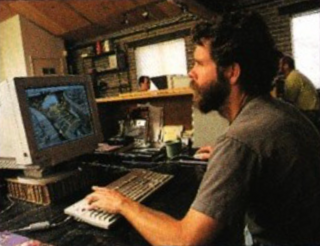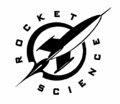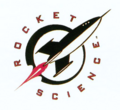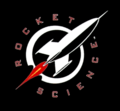Difference between revisions of "Rocket Science Games"
From Sega Retro
m (ref) |
m (+Artwork) |
||
| Line 54: | Line 54: | ||
*[[Press Release: 1996-11-22: Blasting Onto Store Shelves, SegaSoft's Rocket Jockey Has Begun Shipping In Time for the Holiday Season]] | *[[Press Release: 1996-11-22: Blasting Onto Store Shelves, SegaSoft's Rocket Jockey Has Begun Shipping In Time for the Holiday Season]] | ||
*[[Press Release: 1997-02-12: SegaSoft, Inc. Names Jim Noonan VP, Product Acquisitions]] | *[[Press Release: 1997-02-12: SegaSoft, Inc. Names Jim Noonan VP, Product Acquisitions]] | ||
| + | |||
| + | ==Artwork== | ||
| + | <gallery> | ||
| + | RocketScienceGames logo bw.png | ||
| + | RocketScienceGames logo alt.png | ||
| + | RocketScienceGames logo.png | ||
| + | </gallery> | ||
==External links== | ==External links== | ||
Revision as of 19:50, 12 February 2023
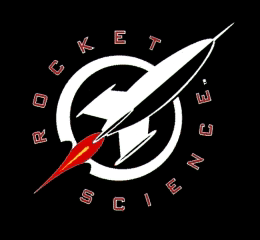
| ||||||
| Rocket Science Games | ||||||
|---|---|---|---|---|---|---|
| Founded: 1993-07[1][2] | ||||||
| Defunct: 1997-04[3][4][5] | ||||||
| T-series code: T-153 | ||||||
Headquarters:
|
Rocket Science Games Inc. was a video game developer based in California's San Francisco Bay Area which produced both home and computer games from 1993 to 1997. The company was most known for their use of full-motion video in titles such as Loadstar: The Legend of Tully Bodine and Obsidian.
Contents
Company
Rocket Science Games was first conceived by businessman and avid gamer Peter Barrett around January 1993.[9] When pitched to his close friend and Silicon Valley entrepreneur Steve Blank, Barrett recalls the latter being initially disinterested. But when Barrett described the proposed company's high concept of "Hollywood meets CD-ROM", Blank grew much more interested.[10]
| “ | Peter described the first company in which ‘Hollywood meets Silicon Valley’ and we were enthralled. When he elaborated how CD-ROMs were going to change both the nature of gaming and the economics of the content business, we were certain he had a brilliant idea and by the end of the meeting convinced that this was a company would make a ton of money. | „ |
— Co-founder Steven Blank[10] | ||
After the meeting, the two spent the next month gathering about $4,000,000 in capital[10], and in July 1993[1] officially opened Rocket Science Games in Palo Alto, California - in close proximity to a number of software publishers, including Sega of America. A second location in nearby Berkeley served as the company's design and production facility.[8] To bolster their concept of a "Hollywood" studio, the company built its initial business strategy around investing heavily in hiring a celebrity development team. LucasArts’ Brian Moriarty was one such developer, with additional staff recruited from Industrial Light & Magic, Amblin Entertainment, Marvel Comics, Apple Computer.[11] Blank recalls Peter Barrett's credentials being a major factor in convincing staff to join; having developed the Cinepak format, Barrett was an expert in video compression, and his presence helped instill confidence in a new company building itself around the tepidly-received concept of full-motion video.
With their Hollywood staff, Rocket Science Games went all-in on full-motion video, beginning their existence not producing games but the development hardware needed to create these games; specifically, Hollywood-style big budget "interactive movies", with their target platforms being the Sega CD and personal computers. Like Hollywood, production was exorbitantly expensive, with titles routinely costing the company a few million dollars each. All this investment occurred while FMV games were in their decline, and with the company aware that this genre generally sold quite poorly; they were assured in their presentation surpassing previous attempts at making FMV profitable.
| “ | “When I looked around at our executive staff, there wasn’t a single founder who was a gamer. Worse, there wasn’t a single person on our executive team who had come from a game company. Nor was there anyone with game experience on our board. […] When I pointed out my rising apprehension, [Peter Barrett’s] response was, ‘I’ve been playing games since I was 10. I know what’s great and what’s not. We agreed this part of the company was my responsibility. Don’t worry the games are going to be great.’ | „ |
— Co-founder Steven Blank[12] | ||
Blank recalls that Rocket Science Games was focused almost entirely on appearances and little on actual gameplay, claiming none of the executive staff were gamers[13], and that the Hollywood presentation was fooling the company into ignoring the lack of gameplay.[14] At some point, Rocket Science Games hired their vice president of marketing directly from Sega of America, who, after only two weeks with the company, began to voice strong concerns about the lacking gameplay; that these games lacked the addictive power to keep gamers wanting to play.[12] The company's disregard for gameplay was reportedly so severe that the game Loadstar: The Legend of Tully Bodine was produced without any playtesting. Once the programmers had finished bringing the game to a relatively bug-free state, that version was immediately finalized, with Rocket Science Games so confident in their expensive presentation that they felt no need to actually playtest it for balance or fun.
Despite the poor reputation of full-motion video, the developer's focus on highly-marketable presentation and industry hype eventually garnered a significant amount of interest from both investors and fellow game companies. In May 1994, Rocket Science Games was awarded with $12 million in funding from Sega Enterprises and the Bertelsmann Music Group[15] in exchange for the two companies becoming the developer's exclusive North American and European publishers, respectively. Around this same time, the company's two development facilities would later be consolidated together and relocated to a suite in San Francisco's South of Market neighborhood.[7]
Even with the developer's significant investment in making their vision of FMV gaming profitable, their first games (Loadstar: The Legend of Tully Bodine and Cadillacs and Dinosaurs: The Second Cataclysm were released to mixed reviews and extremely poor sales. Despite production budgets upwards of $3,000,000, the company was shocked to see their flagship games sell less than a few thousand copies each.[16]
| “ | We raised $35 million and after 18 months made the cover of Wired magazine. The press called Rocket Science one of the hottest companies in Silicon Valley and predicted that our games would be great because the storyboards and trailers were spectacular. 90 days later, I found out our games are terrible, no one is buying them, our best engineers started leaving, and with 120 people and a huge burn rate, we’re running out of money and about to crash. This can’t be happening to me. | „ |
— Co-founder Steven Blank[12] | ||
By the middle of 1996, the situation at Rocket Science Games was dire. With sales virtually nonexistent, the company was struggling just to stay in operation[12], and with attempts to commercialize its CD-ROM development software having proven fruitless.[17] Thankfully, in August of that year the company would receive much-needed funds from SegaSoft, who entered into an agreement to become the developer's sole publisher; although according to company investor Kathryn Gould, "we ended up selling to Sega for nothing".[18] The company underwent heavy restructuring, ceased to become a publisher itself, and was refocused solely on computer game development. A staff of 100 was downsized to 35, including gutting most of upper management and building the studio around the developers. Blank and Barrett left during this restructuring, with Barrett placing some of the blame on Sega and the Sega CD - claiming "they had backed the wrong horse". A number of in-development games were cancelled during this downsizing, including a sequel to Loadstar (for which the live-acting filming was reportedly complete) and a roller coaster simulator titled DarkRide.[16]
Unfortunately, this tightening of an already-failing developer had a noticeably negative effect on the quality of their future games. The much-hyped Rocket Jockey shipped missing LAN support that had been heavily promoted to the press and was even advertised on the game's box; it wouldn't be patched into the game for several months. Obsidian also suffered from significant quality issues upon launch, containing several bugs which prevented completion of the game entirely. While the company's SegaSoft games did see some level of critical acclaim, none of them did particularly well financially, and unable to secure additional funding, Rocket Science Games was forced to close down in April 1997.[5] While the developer's main business appears to have been shuddered, a barebones staff was retained in some capacity to finish the publishing of The Space Bar and Darwin Pond. Although it was hoped that the success of these games would convince SegaSoft to take a second chance on the company, this did not come to pass.[5] Ultimately, after having lost nearly $35,000,000 over the course of its four years in business[13], Rocket Science Games was permanently closed.
InterARC
| “ | InterARC is the first attempt by a major player in the gaming industry to introduce pay-by-play dynamics to the Internet. Working in tandem with CyberCash, Rocket Science is developing the ability to charge sub-dollar amounts for transactions over the Internet. In other words, instead of dropping $50 bones for a whole game, you can pay for games on a per use basis-- just like the arcades! | „ |
— Official website[19] | ||
In February 1996, Rocket Science Games announced a partnership with CyberCash, Inc. to launch a virtual arcade service based on micropayments. CyberCash, a virtual currency company, would provide the financial infrastructure for the platform and use it to jump-start their "electronic coin service". This announcement was heavily circulated by the media and, along with several other micropayment-based services of the mid 1990's, was heralded as the "next big thing" in internet commerce.
The service, later receiving the name InterARC (Internet Arcade)[19], was never given a firm launch date nor were any specific titles mentioned. After the initial flurry of excitement, the partnership failed to produce any further announcements and the service was never heard from again. As SegaSoft had acquired Rocket Science Games only half a year after InterARC's announcement, it is assumed the platform was a casualty of the cuts made by the publisher in late 1996. Despite this, SegaSoft would later partner with CyberCash and use their micropayment system (now named CyberCoin) for their Heat.net online gaming service.
Softography
Mega-CD
- Loadstar: The Legend of Tully Bodine (1994)
- Cadillacs and Dinosaurs: The Second Cataclysm (1994)
- DarkRide (unreleased)
- Loadstar II: Showdown on Phobos (unreleased)
- Rocket Boy (unreleased)
- Wing Nuts: Battle in the Sky (unreleased)
Mega-CD 32X
- DarkRide (unreleased)
- Rocket Boy (unreleased)
- Wing Nuts: Battle in the Sky (unreleased)
Saturn
- DarkRide (unreleased)
- Ganymede (unreleased)
- Rocket Boy (unreleased)
- Wing Nuts: Battle in the Sky (unreleased)
IBM PC
- Wing Nuts: Battle in the Sky (unreleased)
Windows PC
- Obsidian (1996)
- Rocket Jockey (1996)
- Darwin Pond (unreleased)
Magazine articles
- Main article: Rocket Science Games/Magazine articles.
Press releases
- Press Release: 1996-08-13: SEGASOFT TO PUBLISH FOUR ROCKET SCIENCE GAMES TITLES; ACQUIRES STARHILL BRAND
- Press Release: 1996-09-01: SegaSoft Alters Reality With the Launch of Obsidian
- Press Release: 1996-11-22: Blasting Onto Store Shelves, SegaSoft's Rocket Jockey Has Begun Shipping In Time for the Holiday Season
- Press Release: 1997-02-12: SegaSoft, Inc. Names Jim Noonan VP, Product Acquisitions
Artwork
External links
- Official website (1996-11; Wayback Machine)
- Official website (InterARC) (1996-11; Wayback Machine)
- Rocket Science: The first digital supergroup is about to serve up addictive thumb candy - or become the next smoking crater in the videogame biz article by Burr Snider at WIRED
- It Ain't Rocket Science, Stupid, It's Marketing article by Burr Snider at WIRED
- Rocket Science taps H’wood talent for CD games article by Matt Rothman at Variety
- Times Mirror to Invest in Game Company : Media: The publishing firm will put about $5 million into Rocket Science Games, a highly regarded start-up article by Amy Harmon at The Los Angeles Times
- Loadstar: The Legend of Tully Bodine article by Cassidy at Bad Game Hall of Fame
References
- ↑ 1.0 1.1 1.2 http://variety.com/1993/biz/news/rocket-science-taps-h-wood-talent-for-cd-games-109022/ (Wayback Machine: 2017-02-22 02:27)
- ↑ 2.0 2.1 https://alter.com/trademarks/rocket-science-games-75975836
- ↑ Next Generation, "July 1997" (US; 1997-06-17), page 24
- ↑ https://www.science.org/content/article/scientists-computer-gaming-going-game-university (Wayback Machine: 2023-02-07 08:05)
- ↑ 5.0 5.1 5.2 https://www.wired.com/1997/04/rocket-science-takes-a-dive/ (Wayback Machine: 2020-11-30 09:28)
- ↑ https://www.pch.net/resources/NSFNET/regional-techs.94.02 (Wayback Machine: 2022-12-27 22:52)
- ↑ 7.0 7.1 7.2 7.3 https://steveblank.com/2009/06/01/rocks-in-the-rocket-science-lobby/ (Wayback Machine: 2022-10-04 10:33)
- ↑ 8.0 8.1 https://www.wired.com/1994/11/rocket-science/ (Wayback Machine: 2023-01-17 02:45)
- ↑ https://www.linkedin.com/in/steveblank/details/experience/
- ↑ 10.0 10.1 10.2 https://steveblank.com/2009/07/02/rocket-science-2-drinking-the-kool-aid/ (Wayback Machine: 2022-10-05 01:41)
- ↑ 11.0 11.1 Sega Visions, "August/September 1994" (US; 1994-xx-xx), page 18
- ↑ 12.0 12.1 12.2 12.3 https://steveblank.com/2009/07/16/rocket-science-5-who-needs-domain-experts/ (Wayback Machine: 2022-10-05 02:41)
- ↑ 13.0 13.1 https://review.firstround.com/Looking-for-Love-in-All-The-Wrong-Places-How-to-Find-a-Co-Founder
- ↑ https://review.firstround.com/Looking-for-Love-in-All-The-Wrong-Places-How-to-Find-a-Co-Founder (Wayback Machine: 2023-01-31 07:54)
- ↑ http://www.wired.com/wired/archive/2.11/rocket.science.html
- ↑ 16.0 16.1 https://www.badgamehalloffame.com/ (Wayback Machine: 2023-01-19 21:34)
- ↑ https://www.telecompaper.com/news/rocket-science-games-is-new-video-games-firm--10159
- ↑ https://epdf.pub/the-kingmakers-venture-capital-and-the-money-behind-the-net.html (Wayback Machine: 2023-02-07 08:04)
- ↑ 19.0 19.1 http://www.rocketsci.com/interarc.html (Wayback Machine: 1996-11-14 06:35)
